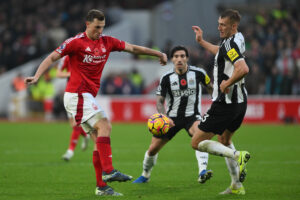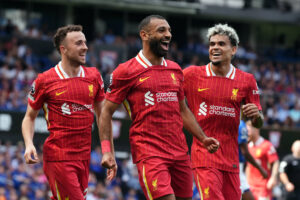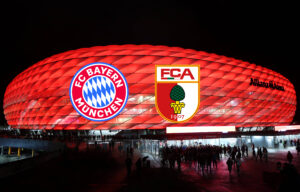“We play three in midfield. Danny Drinkwater in the middle, with N’Golo Kante either side” joked Steve Walsh, then head of recruitment when Leicester City won the Premier League title in 2015/16. And it became a running gag. Another “Kante-Fact,” as they came to be known, sarcastically stated as indisputable truth that 75% of the Earth is covered by water, and the other 25% by Kante. Eden Hazard joked playing with Kante at Chelsea was akin to playing with twins.
Yet despite his world-class talent, no one seems to agree on Kante’s best position. Practically every manager he’s had in England has put him in a different formation and role. Is he a holding midfielder, can he play box to box? And should they play a two or three-man midfield?
The N’Golo Kante Role: The Creative, Free Defensive Midfielder
Not Claude Makelele
Kante often gets compared to ex Chelsea midfielder Claude Makelele. But these comparisons are misleading; Kante does not play the Makelele Role.
When Makelele joined Chelsea, moreover starting with his second year under new manager Jose Mourinho, he imposed himself in the middle of the park. Defensively, he was the destroyer, hunting down the ball at all times. But, having played more advanced earlier in his career, he also had the creative vision and passing ability to open teams up with through balls, switches, and balls over the top.
Kante without a doubt clogs the midfield as well as, if not better, than his compatriot. But, after winning the ball is where he differs. He doesn’t turn and play the quarterback role to start the counter-attack like Makelele. More often, Kante will pass to a teammate close by who then starts the attack.
To continue the NFL analogy, Kante wins the ball, then hands it off to the quarterback. At Leicester, that was Drinkwater. At Chelsea, it was Cesc Fabregas in the beginning and Jorginho more recently.
Kante compares well to Makelele on the defensive side of the ball, but not in attack. And especially not in sparking counter attacks. However, just as it would be disingenuous to say he plays the Makelele Role, it would be equally disingenuous to call Kante a holding midfielder.
Not Holding Down The Fort
As his former coach Gianfranco Zola eluded to, how can Kante cover so much ground if he’s a holding midfielder? Walsh and Hazard also proved with their comments that Kante is not merely sitting in the centre of the park as the number six shielding the backline.
Zola continued on that Drinkwater sat and Kante ran everywhere at Leicester. And the same when partnered with Matic at Chelsea; the Serbian would sit.
Calling him a holding midfielder would imply he lacks discipline, running around covering every blade of grass instead of sitting in centrally in front of the defence. That is foolish, though, of course. No one does or should call him undisciplined.
Not Box To Box
So if he’s not a holding midfielder, and he doesn’t play the Makelele role either, that only leaves his current role as a box to box midfielder. Former manager Maurizio Sarri and current one Frank Lampard receive heaps of praise from fans for playing Kante box to box. This is because now he can get forward and show off his attacking talent which was held back for years. That, however, is simply both wrong and robbing Peter to pay Paul.
Does Kante show some flashes of brilliance on the ball? Sure. But is he great going forward? That’s a stretch. He’s an above-average midfielder in attack at best.
More importantly, though, playing box to box limits what he does best, ball hunt and destroy. Playing box to box, he more or less needs to stay on one side of the pitch, usually the right side.
So, he can play further up the field to get a couple more goals. But, this is at the cost of losing some of his defensive work.
Has Kante scored more goals in the advanced position? Of course. But not because he’s so skilled going forward. On the contrary, it’s his footballing intelligence that puts him in great positions and makes up for his lack of attacking prowess.
In the same way, he can read the defensive side of the game and put himself five steps ahead, he does that in attack. But he’s not clinical enough in front of goal, when dribbling, or passing to open up the game. Attacking wise, he’s very average.
Plus, scoring more for Chelsea than he did for Leicester also comes down in part to playing further up the pitch and in a team that has much more possession.
So, then, if he’s not what people think he is, what is his best position? Well, quite frankly, no position. Or more precisely, not one we know of or recognize.
N’Golo Kante’s Role
Kante’s best position, the one he played at Leicester and with Chelsea originally, is unique to him and the way he plays it. Therefore, it should be called the Kante Role – the free-roaming, creative defensive midfield role. In the way a number 10 has a free role to be creative in attack and roam where he wants, Kante does the same, but the defensive version of it. Think of him as the inverse of the number 10.
He has license to freely roam, read the game the same way a number 10 does, but so he can destroy instead of score. If he needs to run left to win the ball, he’ll do it. He can stop a counter going down the right flank if needed. And he’ll press the opponents in their half to put them under pressure. The main thing is Kante must be free to read the game, get ahead of the play, and intervene every time the opposition gets on the ball.
Was Makelele the first player to play the game the way he did? Probably not, just as Johan Cruyff probably wasn’t the first to turn nor was Antonin Panenka the first to chip the keeper on a penalty. But their names became synonymous with what they did, likely because of the emergence of TV showing games all around the world.
And the same should go for Kante and the Kante Role. It may seem odd to think of a defensive player having a “free” role because defences, especially successful ones, must have discipline, grit, structure, and a plan. A “free” role, though, seems to fly in the face of all that. Yet Kante has worked it to perfection.
Loads of players play as a number 10. But very few are a true number 10. Loads of players probably have tried to play the same way as Kante. But there are very few who can play it well. And no one can do it like him.
Like Makelele, Cruyff, and Panenka, Kante’s name should be immortalized with the Kante Role – the inverse of a number 10, a defensive free role allowed to roam and destroy at will.
Main Photo






